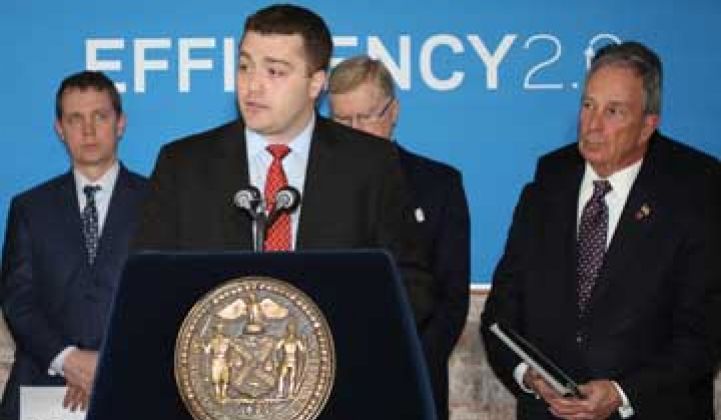Earlier this year, Blake Burris, Spring Ventures and a team of local organizers produced hosted their second Cleanweb Hackathon in New York City. Not to be outdone in his own backyard, Mayor Michael Bloomberg announced on Monday that the city will host its own "Greener, Greater Hackathon" this summer.
The weekend event will “challenge data scientists, developers and designers to use environmental data to create tools and apps that empower New Yorkers to live greener, greater lives,” according to the website.
The announcement, which was made at Efficiency 2.0’s newest offices in the Flatiron district, comes at a time of proliferating sustainability hackathons in New York and other cities. From EnergySTAR comparisons to smart meter data to building energy benchmarking, there is a growing body of information that is ripe to be picked and repackaged in consumer-friendly packaging.
And although New York City might have more than 1,000 tech startups, there is always an eye on California. Earlier in the day, Efficiency 2.0 announced it was powering Southern California Edison’s new Home Energy Advisor and Business Energy Advisor platforms.
The advisor tools meet the requirement by the California Public Utility Commission that requires that the utilities each have an integrated demand-side management tool that integrates residential, small and mid-size business, demand response and California Solar Initiative recommendations into one tool.
“Our market-leading energy advisory software motivates consumers to act on highly personalized advice to help transform the California energy efficiency market,” said Tom Scaramellino, CEO of Efficiency 2.0. “Utilities are under pressure from both regulators and markets to ensure customers make smarter energy choices, and the Energy Advisors are a direct response to that need.”
Efficiency 2.0 is one of many companies that are already supporting the Green Button. The California utilities spearheaded adoption of the White House's Green Button, a feature that allows residential and commercial customers to download detailed energy-use information in a standardized format to better manage electricity consumption and cost.
The early success of the Green Button, which is being used by 16 utilities, has also spawned a national apps contest with a prize purse of $100,000.
In New York, solar is growing, but hardly at the rate that it is in California. Mayor Bloomberg announced the city has tripled its solar power with 10 projects on city buildings across the five boroughs. It’s certainly a good start, but at 648 kilowatts, it’s only a splash in the solar bucket compared to what some California communities are doing. (Los Angeles, for example, is allowing its municipal utility to enter into up to 150 megawatts of feed-in tariff contracts with commercial and residential power producers.) However, New York could put up to 20 megawatts of renewable energy on Staten Island.
For the Big Apple, there has been far more action in efficiency. The city is currently saving $32 million annually from energy efficiency retrofits in 143 municipal buildings, according to Mayor Bloomberg. New York also has one of the more aggressive energy benchmarking disclosure requirements in the country.
The city has also put out requests for proposals to turn 450 tons of city waste into clean energy every day. New York City is also the first city in the nation to purchase hybrid diesel street sweepers, according to the mayor.
“Clearly, cleantech makes good business and environmental sense,” said Bloomberg. “It is in our power to give our city a sustainable future.”



